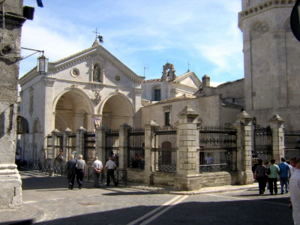History
The legend of the Archangel's apparition at Gargano is related
in the Roman Breviary for May 8. According to the Catholic Encyclopedia,
in Michael's veneration at Monte Gargano (Garganus Mons), "his
original glory as patron in war was restored to him," for
the earlier shrine, at Chonae near Colossae, east of Laodicea
(modern Khonas, east of Denizli) on the Lycus in Phrygia, was
dedicated to him as healer; it is still the site of a miraculous
church of St. Michael.
The first apparitions of the archangel Michael in Western
Europe were granted to the Bishop of Sipontum (rebuilt in
1256 as Manfredonia), in Apulia. Three times the Archangel
appeared, nightly, the last time on September 29, 493, the
bishop reported. The Archangel indicated the transformation
into a Christian church of a grotto sacred to Mithras, on
Monte Tumba[1]. Miraculously, when the bishop and companions
arrived, a purple cloth was already laid as for an altar,
and the archangel's footprint was preserved in the rock.
The Golden Legend (Legenda Aurea), the compendium of Christian
mythology compiled by Jacobus de Varagine between 1260-1275,
narrates the first of the apparitions of Michael:
“ When he appeared in the Mount of Gargan. This mountain
is in Naples, which is named Gargan and is by the city named
Syponte. And in the year of our Lord three hundred and ninety,
was in the same city of Syponte a man which was named Garganus,
which, after some books, had taken that name of the mountain,
or else the mountain took the name of the man. And he was
right rich, and had a great multitude of sheep and beasts,
and as they pastured about the sides of the mountains it happed
that a bull left the other beasts, and went upon high on the
mountain and returned not home again with the other beasts.
Then this rich man, the owner, took a great multitude of servants,
and did do seek this bull all about, and at the last he was
found on high on the mountain by the entry of a hole or a
cave. And then the master was wroth because he had strayed
alone from other beasts, and made one of his servants to shoot
an arrow at him. And anon the arrow returned with the wind
and smote him that had shot it, wherewith they of the city
were troubled with this thing, and went to the bishop and
inquired of him what was to be done in this thing, that was
so wonderful. And then he commanded them to fast three days
and to pray unto God. And when this was done Saint Michael
appeared to the bishop, saying: Know ye that this man is so
hurt by my will. I am Michael the archangel, which will that
this place be worshipped in earth, and will have it surely
kept. And therefore I have proved that I am keeper of this
place by the demonstrance and showing of this thing. And then
anon the bishop and they of the city went with procession
unto that place, and durst not enter into it, but made their
prayers withoutforth. ”
Pope Gelasius I (reigned 492-496) directed that a basilica
be erected enclosing the space. The Basilica di San Giovanni
in Tumba is the final resting-place of the Lombard king Rothari
(d. 652); the designation "tumba" is now applied
to the cupola on squinches.[2]
To Michael's dramatic later intercession, appearing with
flaming sword atop the mountain, in the midst of a storm on
the eve of the battle, the Lombards of Sipontum attributed
their victory (May 8, 663) over the Greeks loyal to the Byzantine
emperor, and so, in commemoration of this victory, the church
of Sipontum instituted a special feast honoring the Archangel,
on May 8, which then spread throughout the Catholic Church.
Since the time of Pius V it has been formalized as Apparitio
S. Michaelis although it originally did not commemorate the
apparition, but the victory of the barbarian Lombards over
the Orthodox Greeks, faithful subjects of the Byzantine Emperor
in the East and the patriarch of Constantinople, and thorns
in the papal side.
Christened "Monte Sant' Angelo", the site attracted
pilgrims from near and far. Throughout its history the shrine
at Monte Gargano has been visited by popes emperors and saints:
Bernard of Clairvaux, Thomas Aquinas, Birgitta of Sweden—
but when Francis of Assisi went, he declined to enter the
grotto itself.
Architecture
The complex of buildings consists of the Battistero di San
Giovanni in Tumba, damaged in 1942, and the Church of Santa
Maria Maggiore. The baptistery presents a rectangular storey
on which rests an octagon supporting an elliptical section
and a high drum that supports the cupola. The church erected
in the eleventh century by Archbishop Leone stands upon the
remains of an ancient necropolis. A few remnants attest to
its once-rich fresco decoration.
The Castello was enlarged by the Normans upon an episcopal
residence of Orso, Bishop of Benevento, to provide a suitable
seat for the Honor Montis Sancti Angeli, further modified
by Frederick II.[3] The massive, octagonal campanile was built
in the late 13th century by Emperor Frederick II of Sicily
as a watchtower. It was turned into a bell tower by Charles
I of Anjou.
Behind a forecourt the sanctuary presents a portico of two
Gothic arches, the right one of 1395 by the local architect
Simone, the left one a reconstruction of 1865. From the portico
steps lead down to the low arched nave. The cavern can be
accessed from a Romanesque portal, called the Portale del
Toro ("Gate of the Bull"): the doors, in bronze,
were made in Constantinople in 1076, the donation of an Amalfitan
noble. They are divided in 24 panels portraying episodes of
angels from the Old and New Testaments.
The archaic cavern opening to the left, with its holy well,
is full of votive offerings, especially the 12th century marble
bishop's throne supported on crouching lions.[4] Among the
ex voto objects is a statue of the Archangel by Andrea Sansovino. |



